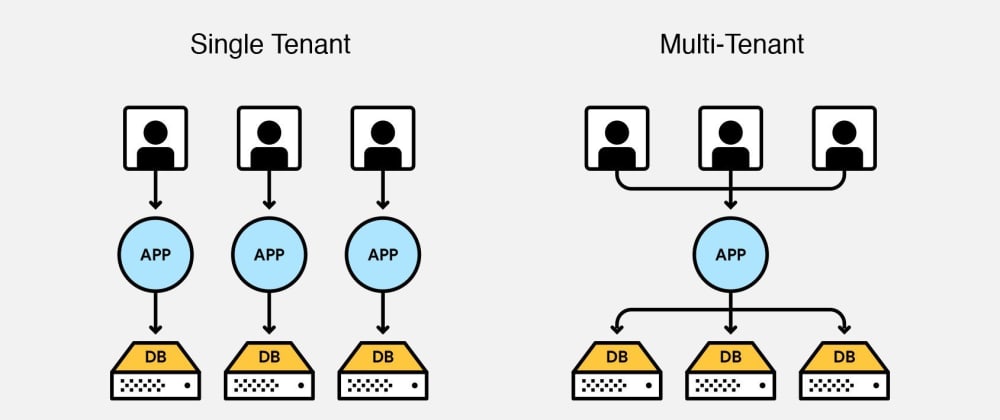
Types of Architectures
In the context of a SaaS (Software as a Service) application, a multi-tenant architecture is one in which a single instance of the application is used by multiple customers, or tenants. Each tenant has their own data and configuration, but they all share the same codebase and infrastructure. This can be more efficient from a resource standpoint, as the infrastructure can be shared among multiple tenants, but it can also pose challenges in terms of security and data isolation.
On the other hand, a multi-instance architecture is one in which each tenant has their own separate instance of the application. This can provide better data isolation and security, as each tenant's data is stored in a separate instance and is not shared with other tenants. However, it can be less efficient from a resource standpoint, as each tenant requires its own separate instance of the application and infrastructure.
Both multi-tenant and multi-instance architectures have their own pros and cons, and the best approach for a given SaaS application will depend on the specific requirements and needs of the application and its users.
Mutiple tenants advantages
There are several advantages to using a single instance of a SaaS application for multiple customers, also known as a multi-tenant architecture:
- Cost efficiency: A multi-tenant architecture can be more cost-effective, as the infrastructure and resources required to run the application can be shared among multiple tenants. This can result in lower costs for both the provider and the customers.
- Improved scalability: A multi-tenant architecture can be more scalable, as the application can easily be scaled up to handle increased demand from multiple tenants without the need to provision additional resources for each tenant.
- Faster deployment and updates: With a multi-tenant architecture, new features and updates can be rolled out to all tenants at once, rather than having to update each tenant's instance individually. This can result in faster deployment and updates for the provider and the customers.
- Easier maintenance: A multi-tenant architecture can be easier to maintain, as the provider only has to maintain a single instance of the application, rather than multiple instances for each tenant.
- Improved security: A multi-tenant architecture can also provide improved security, as the provider can implement security measures at the application level that are applied to all tenants, rather than having to implement them separately for each tenant's instance.
Multi-instance architecture
There are several advantages to using a multi-instance architecture for a SaaS application, in which each tenant has their own separate instance of the application:
- Improved data isolation: With a multi-instance architecture, each tenant's data is stored in a separate instance and is not shared with other tenants. This can provide better data isolation and security, as there is no risk of data leakage between tenants.
- Greater customization: A multi-instance architecture allows for greater customization of the application for each tenant. Each tenant can have their own unique configuration and settings, which can be tailored to their specific needs and requirements.
- Better performance: In some cases, a multi-instance architecture can provide better performance, as each tenant's instance is dedicated to their specific needs and is not shared with other tenants.
- Easier compliance: A multi-instance architecture can be easier to comply with certain regulations and requirements, such as data protection laws, as it provides a higher level of data isolation and control.
- Greater flexibility: With a multi-instance architecture, it is easier to add or remove tenants and to scale the application up or down as needed. This can provide greater flexibility for the provider and the customers.
What do we use for ONLZ application ?
Our application is based on a Multi-instance architecture. It's allowing better compliance. A multi-instance architecture can indeed make it easier to comply with certain regulations and requirements, such as privacy laws, as it provides a higher level of data isolation and control.
Overall, a multi-instance architecture can provide a higher level of security and anonymity for a SaaS voting application used for social elections, as it allows for greater customization and control over the security measures and data isolation for each tenant.
Scalability of each individual tenant is also ensured. If fir instance a specific company is recieving a huge amount of traffic, ONLZ application automaticaaly scale up the infrastructure supporting this customer. It has not impact on other customets whatsover.
OINLZ is composed of a very strong DevSecOps team that is able to deploy any security patch to all instances within few minutes in case of need, without service discontinuity by using a multinode architecture.
Conclusion
A multi-instance architecture is more secured and better for an online voting system for several reasons.
First, a multi-instance architecture provides improved data isolation, as each tenant's data is stored in a separate instance and is not shared with other tenants. This can help prevent data leakage between tenants and ensure that the votes of one tenant are not linked to the votes of another tenant.
Second, a multi-instance architecture allows for greater customization of the application for each tenant. This can include setting up specific security measures and controls to ensure the anonymity and integrity of the votes, such as encryption, access controls, and audit logs.
Third, a multi-instance architecture provides greater flexibility in terms of setting up the application for different elections and ensuring that the appropriate level of security and anonymity is in place. This can include the ability to add or remove tenants and scale the application up or down as needed.
Overall, a multi-instance architecture can provide a higher level of security and anonymity for an online voting system, as it allows for greater customization and control over the security measures and data isolation for each tenant.







